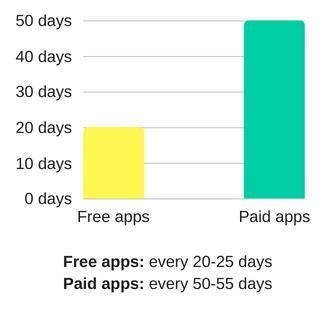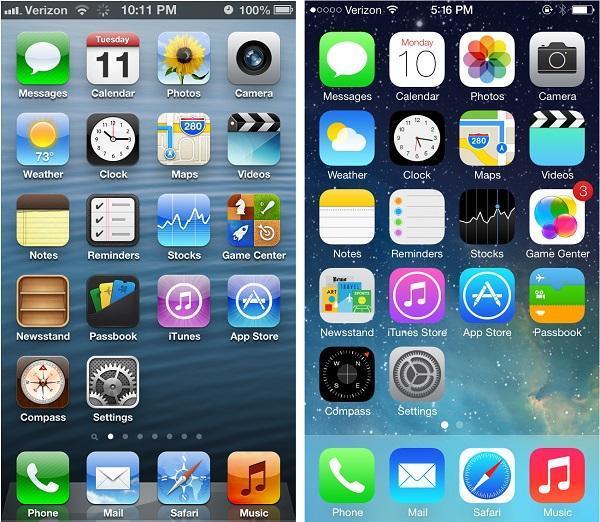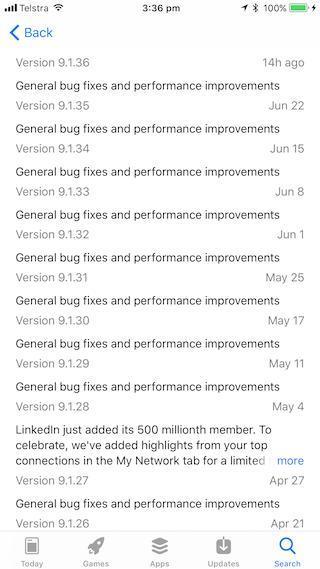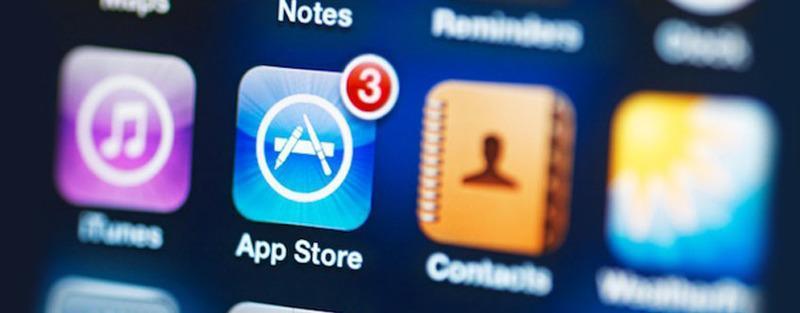We rarely talk about the benefits of updating apps on our blog. We're used to discussing app development itself and explaining how to build an application of a particular type. However, if the app has already been created, what's next? Can a mobile service owner afford to rest on his laurels? In fact, no, the main job has just begun! Because if the creation of an application is a difficult task, app maintenance is not a much easier one. That’s when mobile app updates come to the rescue! But how often should you update your application? And whether you need to do this at all? What issues can be found?
Why is it important to update your app?
Sometimes users ask: why do apps update so often, although there are no noticeable changes (in most cases)? The fact is that the whole mobile development industry is changing rather quickly: new technologies are emerging, and operating systems are being improved. The maintenance services are of great importance.
Therefore, you, as the application owner, bore the responsibility for its effective functioning. It means, among other things, the necessity to update your app regularly - otherwise, it'll seem abandoned, in downtime, "dead", and obsolete. Sure, you don't want your app to crash or freeze. And, by the way, regular updates are a great way of keeping users interested and providing flawless performance.
Well, let's see why mobile apps need frequent updates.
#1. People love novelties
Yes, people love new things… and new features, when it comes to applications. So do your best to astonish and please your users by offering them interesting and helpful iOS and Android app updates.
In addition, by updating your app, you're getting a great excuse to send a pop-up notification to show your users that you care about their wishes.
#2. Down with everything that has lost relevance
Life goes forward, everything is changing... this applies to applications too. You need constant performance monitoring. It's important to understand that any mobile service is not an old chest stuffed with unnecessary things; on the contrary, it is a living object that must be constantly evolving to meet the users’ needs and be innovative programming technology.
#3. Status factor
Users can always see when the application was last updated on Google Play or Apple Store. And if the mobile app update frequency leaves much to be desired, do not expect that you (that is, your company) will be taken seriously.
Of course, you can ask: "How often should I update my app on a store to be respected?" We will answer you this question. Just keep reading.
#4. Adjustment of your mobile strategy
We hope you understand how important it is to collect statistics to find out how popular your application is. Perhaps, mobile app updates are not your favorite job to do, but the need to perform this work gives other results too - you can check the statistics and draw conclusions about whether you need to change something in your mobile strategy. It is a kind of communication with users.
#5. Improvement of the user experience
This item of benefits of updating apps summarizes all of the above. With the help of tools, constant mobile app maintenance and regular updates of applications positively affect the rating of the mobile program in the markets, the user reviews, and therefore - the user experience. This also leads to an increase in the amount of app downloads on device (which affects your profit).

So, summarize: why do apps need to be updated so often? Because updates keep a mobile app on top. But what about the frequency of app updating?
App update frequency: every week or once a month?
Applications being frequently updated are more valued not only by customers but also by App Store and Google Play. But still, how often should you update your iOS app (as well as the Android one)?
In principle, there are several quite simple alternatives:
- Regular updates. It means there is a certain system of mobile app updates.
- Out of necessity: bug fixing, new feature release, and so on.
- At will (you update your app whenever you want, without any schedule).
The first two items seem more correct. After all, everything needs its own system. Moreover, you should coordinate the new feature development with a planned update release.
However, what is regular? Once a week, a month, a year? What should you take into account when determining the app update frequency?
Factors to consider
How often should you update your app? Can you do this every week? Why not, if it is so useful?
First of all, Apple and Google wouldn't allow you to update your app every week. And such activity may seem suspicious, and users can say: "It's only been a few days after the last update release! Couldn't you do everything at once?" On the other hand, if you delay the upgrade process, users will doubt the seriousness of your approach to your application business.
Therefore, everything needs a measure and a golden mean, including when it comes to the frequency of app updating. It remains to find this measure.
Statistics data
Reasoning how often to update your app, you should be guided by the statistics data.

As you can see, free applications more often release updates. However, this is natural: in the end, a free application earns on paid features, in-app purchases, advertising... it forces mobile service owners to puzzle over the continual expansion of the app functionality, its improvement.
That is, you should not fanatically concern with the mobile app updates frequency, but you can not delay with the next upgrade either.
In general, comparing 500 top applications, we can summarize that the optimal app update frequency should be from 20 to 40 days.
Reasons for updating your app
Now it's time to discuss the reasons for updating your app. Some of them are obvious, but they should still be mentioned.
#1. App Bug Fixing Updates
This is a rather sad reason for new iOS and Android app updates, but what can you do? No one is perfect and nothing is perfect, including applications. Of course, QA engineers thoroughly test the application before release, but some bugs are very tricky. They appear in later stages (especially if you hurry to publish the application as soon as possible and do not give time for full-fledged testing of the project).
So there is nothing deadly terrible in bugs. The main thing is to catch wind of the situation and make the necessary app bug-fixing updates.
#2. App Feature Release Updates
Do you remember the updated statistics for popular applications? The mobile app updates frequency of free programs is pretty high, and we have already explained why - they are trying to please their users with new interesting features. It's good practice in app management, and you should do the same. And such an approach means regular app feature release updates.
#3. Enhancing the app UI/UX
The functionality of the application, the speed of its operation, stability - all these are very important. But the first thing a user faces when launching your product is what it looks like and what graphic it has. In other words, he should deal with the app design before anything.
What are the reasons to change the design, update and enhance it?
- change in the guidelines. It happens that the platforming company changes its guidelines - as, for example, Apple did when moving to iOS 7, and when the skeuomorph had been replaced by flat icons and translucency. In such cases, you should update your app interface design since the old-style interface elements will look extremely clumsy against the background of the updated system.

- obsolete design. There is no need to follow each new UX/UI trend but it is worth periodically updating your app to modern standards.
- too complicated interface. An intricate interface can confuse an untrained user. The app design should be as simple as possible.
- rebranding the company. Having changed the logo or company colors, it's important not to forget about the mobile application. If your app uses your old logo, or the color palette radically differs from the corporate color of your company, your user may be surprised, and not in a good way.
#4. Operating System app updates
All operating systems are being regularly improved. Apple, for instance, releases a major system update for its platform every year. Android adopts the same policy.
iOS and Android updates serve a great purpose - to provide users with maximum possibilities. Unfortunately, under the conditions of the updated OS, the mobile application can work worse: the information transfer speed is lost, some features refuse to work properly, etc. In this case, you just need to release system app updates that will ensure the application is operating correctly.
#5. User feedback
Your users will surely leave you feedback, and you must take it into account when creating mobile app updates. You will be told about the bugs and defects missed during the testing process and you will ask for missing features. And if you ignore these desires, you can lose a large part of your users.
After all, people love applications that are being constantly improved. Therefore, you must listen to the feedback of users very carefully.
How to approach app updates?
Now you know about the right app update frequency, about reasons to update your app, about everything… it remains to find the best approach to the update release. And this task is more complicated than it may seem.
What’s new?
Of course, it is very important to interest the potential user with the first lines of the app description. But there is one more issue, no less significant: to prove and show the user that the application is being constantly improved.
Of course, we are talking about the section "What's New" - a section that describes mobile app updates.
Organizing the What's New section
What to write further?
Obviously, first of all, the user would be interested in learning about new features. But you should describe the updated functionality from the perspective of an ordinary user, not a developer. Therefore, write in the clear and understandable language, without going into the details of the development and complexities of the coding process.
Do not lose sight of the overall concept too. A simple listing of new features is good, but the text itself must contain a call to action.
There are situations when you have nothing to write about (for example, if it was only app bug fixing updates and optimization). What should you do then? Try to refer to the innovations added in the previous version, tell about adding improvements to them.
Why is it important?
Why is it so important to talk about what you have done when updating your app?
Firstly, the user will be pleased to know how you are planning to surprise him. And secondly, the history of updates is being saved and if you limit yourself to the meager update description, you can get a very dire result, shown in the picture below.

Creative examples of updates' descriptions
Known mobile apps keep updating regularly and always pay due attention to the descriptions of the improvements made. And sometimes such descriptions are quite original.
Developers of the social network named Tumblr once released an update of their iOS application and instead of describing the features that appeared, they decided to insert an art story about how their vice president was thinking over the new version of the product.
The creators of the TalkTo messenger hid the story of a visit to the dentist in the update list and also told about bugs that appeared due to viewing Justin Bieber's clips while working.
The developers of the Yelp service try to regularly create non-standard descriptions of updates by inserting facts from the news agenda. For example, they tell users that there is something more interesting in life than the new album Daft Punk and a new dish at a Taco Bell dinner.
Where and how to promote iOS and Android app updates
Minor mobile app updates and improvements can be released quietly, but if it is a question of some important feature or innovation, then you should announce your achievements anywhere and everywhere.
Distribute promo codes
If the application has been existing in App Store and Google Play for a long time, then you probably managed to gather a certain audience of loyal users. But if you distribute promotional codes just like that, for no reason, then these users will certainly attract some interest, but nothing more. And if you timed the distribution to the upcoming updates, then the interest would be much higher.
Write to the blog
To write about why the app needs to be updated, no special talent is required. In fact, having an information platform under the project has long been considered a good form. Here you can talk about everything that is connected with the company and its products, including mobile app updates and it will be useful for marketing.
Use social networks
It's impossible and unwise to ignore them because your users're actively communicating through social networks to share their thoughts. This is a great way to organize a feedback feed, and all your future announcements and news will find the audience here too.
Push Notifications
If they are being provided, then this is their golden chance. It’s not necessary to use such notifications on the occasion of minor mobile app updates: users do not like being flooded with spam. A major upgrade is quite another matter.
Step-by-step introduction of updates
If you have questions and you keep asking yourself: "Is it necessary to update apps on Android and iOS?", then use the possibility of the step-by-step introduction of updates.
Start with a small portion of users indicated in percentages and gradually increase their number. The choice of users occurs in an absolutely random way. You can not specify any selection parameters. Also, you can not return the previous app version to users who have already installed the update.
Despite the limitations, the step-by-step introduction is a very powerful and useful tool. However, remember that it is only available for mobile app updates, and not for the original app version.
Monitoring the update release date
If the update release is accompanied by additional activities, then the timing is really important. Imagine that the promotion process has already been running, and the update itself has not appeared. It’ll be a failure, and a very tough one. Try to take all possible measures to avoid such an outcome.

As you see, launching a specific application on platforms is extremely important, you need to prepare for it, and yet… yet, it is just a single event. And even if you have gotten the first powerful wave of loyal users after the app creation, the download rating will gradually decrease. And regular updates, with the correct approach, and clear content are the solution to this problem because they can help to revive old types of users and attract new ones.
If you consider app maintenance costs, they involve such aspects as nurturing server, push notifications, payment gateways, and support. There is an increasing quest for security. As the business owner of app development company, you are responsible for the security of your applications and websites.
And by the way, our Agilie team is highly skilled in mobile app development. Moreover, we have a huge experience of long-term and successful projects. So, we are ready to maintain and update your app in addition to creating it.